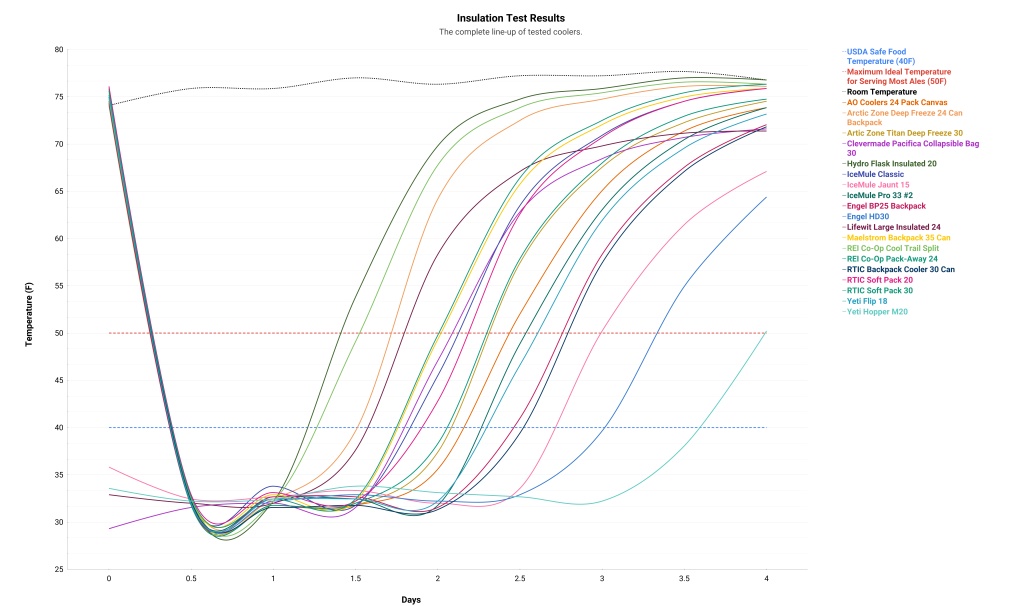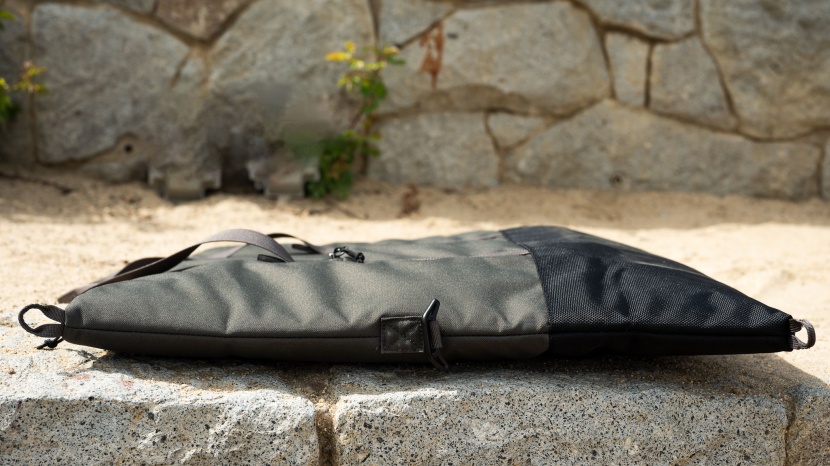Insulation
In keeping with other high testing standards developed by GearLab, all the soft coolers in this category underwent a head-to-head temperature retention test. The FDA recommends keeping perishable food at or below 40 degrees Fahrenheit to ensure maximal freshness and quality. We, too, used this temperature threshold to compare each model's effectiveness. Each cooler was packed 1/2 full of cubed ice. Hidden within the ice was a device to measure internal temperature concealed within a glass mason jar.
The soft coolers were then placed in a room with a controlled temperature of 78 degrees to simulate an average day. After four days, we viewed and compared each cooler's internal temperature data. This data is summarized in several graphs that can be viewed in the main article of this review and incorporated into each cooler's overall insulation score. The following graph represents the temperatures within each cooler over four days. Those that lasted longer below 40 and 50 degrees were awarded more points; after all, the purpose of the cooler is to keep things cold. Those with quickly rising temperatures didn't score as well in this metric. These tests allowed us to assess the insulation of each cooler as objectively as possible.
Convenience
After using these coolers regularly for months, we got very familiar with each one, including how easy they were to use. We've loaded them with lots of beverages and filled them with perishables. We took them to beach days and on kayak trips. We asked our friends to use and evaluate them. As part of our convenience test, we gauged the ease of opening and closing each cooler. Many styles are available, like zippered, clam top, and rollover. Each was deeply evaluated for its simplicity when accessing the internal contents. For example, if there was a zipper, we zipped and unzipped and noted how easy it was to do so.
Next, we looked at the overall structure of each cooler. Because these models are soft, many have the added benefit of folding down to store more easily. As this factor largely differentiates them from hard coolers, we awarded more points to those who stored more easily. Finally, we wiped down and scrubbed each model to see how easy it was to clean and measure how long it took to dry afterward.
Portability
Portability comes down to weight and handles or straps. Smaller coolers are lighter, so we did our best to leave sheer capacity out of this metric. Instead, we considered the capacity vs. weight of each option and the design elements that make each more or less pleasant to carry. We examined the handles and straps of every model we tested. We judged the overall shape and rigidity as they pressed against us en route to our various destinations. And we carried them everywhere. From the car to the picnic table, to the neighbor's house, across the beach, and up trails to reach summits.
Packability
We experimented with coolers of different shapes and sizes, noting how easy or difficult each one was to fit all kinds of different possible foods and beverages inside, including a wine bottle. We also noted any awkwardness when it came to the loading and unloading process, such as if the lid closed on our hands while grabbing a drink. Additionally, we evaluated each model's extra pockets and organizational features to make your cooler experience even cooler.
Durability
Testing the durability of an item meant to last for years in just a few months is a tall order, but we're up for the challenge. Not only did we use each contender in 'normal' ways, but we also beat them up to see how they stood up to the challenge. We yanked on handles and zippers. We dragged them through sand and mud and left them in the rain. We tossed them haphazardly and dropped them on rough surfaces like asphalt. In essence, we did all the things you'd typically try not to do, but could happen anyway. We also inspected each cooler for suspect construction or flaws. Then, we put their waterproofing to the test. We filled buckets with water and submerged them for an entire day. We assessed each bag's exterior, noting whether water permeated the fabric. We then opened the bags to see how much water seeped in, if any. To widen our pool of users, we scoured the internet for other people's complaints and noted those too.


